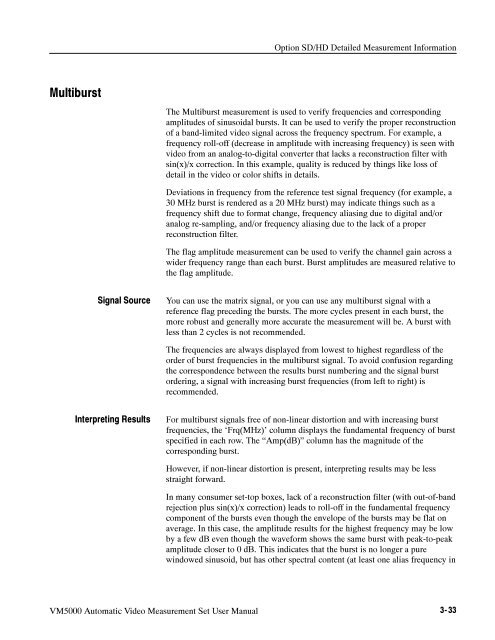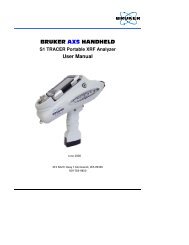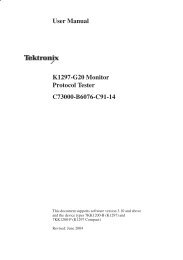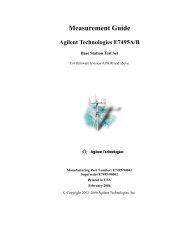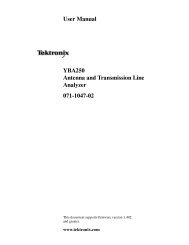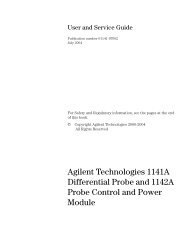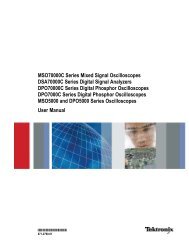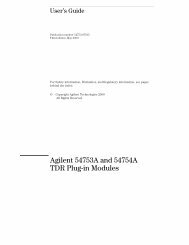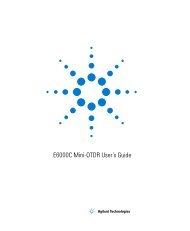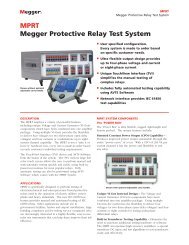- Page 1 and 2:
User Manual VM5000 Automatic Video
- Page 3:
Warranty 2 Tektronix warrants that
- Page 6 and 7:
Table of Contents Reference Display
- Page 8 and 9:
Table of Contents Index Option SD/H
- Page 10 and 11:
Table of Contents Figure 2 -17: Cal
- Page 12 and 13:
Table of Contents Figure 3 -60: Lim
- Page 14 and 15:
Table of Contents Table B -1: Requi
- Page 16 and 17:
Table of Contents xii VM5000 Automa
- Page 18 and 19:
Preface Related Manuals and Online
- Page 20 and 21:
General Safety Summary Symbols and
- Page 22 and 23:
Environmental Considerations xviii
- Page 25 and 26:
Product Description This manual sup
- Page 27 and 28:
Product Description Compatibility o
- Page 29 and 30:
Installation This section addresses
- Page 31 and 32:
Installation Connecting the Mouse T
- Page 33 and 34:
Installation Creating an Emergency
- Page 35 and 36:
Installation Desktop Applications Y
- Page 37 and 38:
Incoming Inspection This section co
- Page 39 and 40:
Incoming Inspection 1. Set the vide
- Page 41 and 42:
Incoming Inspection NOTE. These pro
- Page 43 and 44:
Incoming Inspection Figure 1- 6: Re
- Page 45 and 46:
Incoming Inspection Possible Errors
- Page 47 and 48:
Options and Accessories This sectio
- Page 49 and 50:
Options and Accessories Table 1- 3:
- Page 51 and 52:
Options and Accessories Table 1- 3:
- Page 53:
Operating Basics
- Page 56 and 57:
Operating Basics The VM5000 selects
- Page 58 and 59:
Operating Basics To achieve the bes
- Page 60 and 61:
Operating Basics 4-Wire Video with
- Page 62 and 63:
Operating Basics To connect the RGB
- Page 64 and 65:
Operating Basics To connect the DUT
- Page 66 and 67:
Operating Basics A pop-up warning a
- Page 68 and 69:
Operating Basics 2 Figure 2- 18: At
- Page 70 and 71:
Operating Basics The Matrix Test Si
- Page 72 and 73:
Operating Basics Figure 2 -24 shows
- Page 74 and 75:
Operating Basics For other refresh
- Page 76 and 77:
Operating Basics The VM5000 Applica
- Page 78 and 79:
Operating Basics Setting the Input
- Page 80 and 81:
Operating Basics 5. Select the appr
- Page 82 and 83:
Operating Basics Setting the Measur
- Page 84 and 85:
Operating Basics 5. Auto Scale fits
- Page 86 and 87:
Operating Basics 9. (Option VGA) Th
- Page 88 and 89:
Operating Basics Setting Reference
- Page 90 and 91:
Operating Basics Displaying the Inp
- Page 92 and 93: Operating Basics 4. Sets the width
- Page 94 and 95: Operating Basics 3. Sets the video
- Page 96 and 97: Operating Basics 2. The instrument
- Page 98 and 99: Operating Basics Taking Measurement
- Page 100 and 101: Operating Basics 2. To change a val
- Page 102 and 103: Operating Basics 3. Enter a file na
- Page 104 and 105: Operating Basics 3. Select the Look
- Page 106 and 107: Operating Basics RTF: Use RTF (
- Page 108 and 109: Operating Basics 2-54 VM5000 Automa
- Page 111 and 112: Reference Overview This chapter pro
- Page 113 and 114: Menu Descriptions The following tab
- Page 115 and 116: Menu Descriptions Configuration Men
- Page 117 and 118: Menu Descriptions Menu Item Functio
- Page 119 and 120: Menu Descriptions Menu Item Functio
- Page 121 and 122: Menu Descriptions Command Measureme
- Page 123 and 124: Menu Descriptions Command Reference
- Page 125 and 126: Menu Descriptions Command Function
- Page 127 and 128: Menu Descriptions Menu item Color B
- Page 129 and 130: Menu Descriptions Menu item Non Lin
- Page 131 and 132: Menu Descriptions Command Ch -Ch Sk
- Page 133 and 134: Menu Descriptions Command Luma Leve
- Page 135 and 136: Menu Descriptions Utilities Menu CA
- Page 137 and 138: Option SD/HD Detailed Measurement I
- Page 139 and 140: Option SD/HD Detailed Measurement I
- Page 141: Option SD/HD Detailed Measurement I
- Page 145 and 146: Option SD/HD Detailed Measurement I
- Page 147 and 148: Option SD/HD Detailed Measurement I
- Page 149 and 150: Option VGA Detailed Measurement Inf
- Page 151 and 152: Option VGA Detailed Measurement Inf
- Page 153 and 154: Option VGA Detailed Measurement Inf
- Page 155 and 156: Option VGA Detailed Measurement Inf
- Page 157 and 158: Option VGA Detailed Measurement Inf
- Page 159 and 160: Option VGA Detailed Measurement Inf
- Page 161 and 162: Option VGA Detailed Measurement Inf
- Page 163 and 164: Option VGA Detailed Measurement Inf
- Page 165 and 166: Option VGA Detailed Measurement Inf
- Page 167 and 168: Option VGA Detailed Measurement Inf
- Page 169 and 170: Setting Up Measurements There are t
- Page 171 and 172: Setting Up Measurements 5. Select E
- Page 173 and 174: Setting Up Measurements Option SD/H
- Page 175 and 176: Setting Up Measurements 5. Select E
- Page 177 and 178: Setting Up Measurements The easiest
- Page 179 and 180: Setting Up Measurements There are t
- Page 181 and 182: Setting Up Measurements 2. To chang
- Page 183 and 184: Setting Up Measurements There are t
- Page 185 and 186: Setting Up Measurements 1. Select R
- Page 187 and 188: Setting Up Measurements Setting Up
- Page 189 and 190: Setting Up Measurements Setting Up
- Page 191 and 192: Setting Up Measurements There are t
- Page 193 and 194:
Setting Up Measurements Figure 3- 1
- Page 195 and 196:
Setting Up Measurements The next ti
- Page 197 and 198:
Setting Up Measurements 3. Click th
- Page 199 and 200:
Setting Up Measurements Turn the
- Page 201 and 202:
Setting Up Measurements 3. Click th
- Page 203 and 204:
Setting Up Measurements There are t
- Page 205 and 206:
Setting Up Measurements 2. Click th
- Page 207 and 208:
Setting Up Measurements Turn the
- Page 209 and 210:
Viewing Measurement Results Use the
- Page 211 and 212:
Viewing Measurement Results Display
- Page 213 and 214:
Viewing Measurement Results Referen
- Page 215 and 216:
Viewing Measurement Results Select
- Page 217 and 218:
Viewing Measurement Results Select
- Page 219 and 220:
Viewing Measurement Results Click t
- Page 221 and 222:
Viewing Measurement Results Display
- Page 223 and 224:
Viewing Measurement Results Referen
- Page 225 and 226:
Viewing Measurement Results Display
- Page 227 and 228:
Viewing Measurement Results Referen
- Page 229 and 230:
Viewing Measurement Results Select
- Page 231 and 232:
Viewing Measurement Results Display
- Page 233 and 234:
Viewing Measurement Results Referen
- Page 235 and 236:
Viewing Measurement Results Select
- Page 237 and 238:
Viewing Measurement Results Display
- Page 239 and 240:
Viewing Measurement Results Measure
- Page 241 and 242:
Viewing Measurement Results Select
- Page 243 and 244:
Viewing Measurement Results To disp
- Page 245:
Appendices
- Page 248 and 249:
Appendix A: Specifications Table A-
- Page 250 and 251:
Appendix A: Specifications Table A-
- Page 252 and 253:
Appendix A: Specifications Table A-
- Page 254 and 255:
Appendix A: Specifications Table A-
- Page 256 and 257:
Appendix A: Specifications Table A-
- Page 258 and 259:
Appendix A: Specifications Table A-
- Page 260 and 261:
Appendix A: Specifications Table A-
- Page 262 and 263:
Appendix A: Specifications Table A-
- Page 264 and 265:
Appendix A: Specifications Table A-
- Page 266 and 267:
Appendix A: Specifications Table A-
- Page 268 and 269:
Appendix A: Specifications Option V
- Page 270 and 271:
Appendix A: Specifications Table A-
- Page 272 and 273:
Appendix A: Specifications A-26 VM5
- Page 274 and 275:
Appendix B: Performance Verificatio
- Page 276 and 277:
Appendix B: Performance Verificatio
- Page 278 and 279:
Appendix B: Performance Verificatio
- Page 280 and 281:
Appendix B: Performance Verificatio
- Page 282 and 283:
Appendix B: Performance Verificatio
- Page 284 and 285:
Appendix B: Performance Verificatio
- Page 286 and 287:
Appendix B: Performance Verificatio
- Page 288 and 289:
Appendix B: Performance Verificatio
- Page 290 and 291:
Appendix B: Performance Verificatio
- Page 292 and 293:
Appendix B: Performance Verificatio
- Page 294 and 295:
Appendix B: Performance Verificatio
- Page 296 and 297:
Appendix B: Performance Verificatio
- Page 298 and 299:
Appendix B: Performance Verificatio
- Page 300 and 301:
Appendix B: Performance Verificatio
- Page 302 and 303:
Appendix B: Performance Verificatio
- Page 304 and 305:
Appendix B: Performance Verificatio
- Page 306 and 307:
Appendix B: Performance Verificatio
- Page 308 and 309:
Appendix B: Performance Verificatio
- Page 310 and 311:
Appendix B: Performance Verificatio
- Page 312 and 313:
Appendix B: Performance Verificatio
- Page 314 and 315:
Appendix B: Performance Verificatio
- Page 316 and 317:
Appendix B: Performance Verificatio
- Page 318 and 319:
Appendix B: Performance Verificatio
- Page 320 and 321:
Appendix C: Cleaning Clean the flat
- Page 322 and 323:
Appendix D: Rebuilding the Hard Dri
- Page 324 and 325:
Appendix E: Signal Sources Package
- Page 326 and 327:
Appendix E: Signal Sources Package
- Page 328 and 329:
Appendix E: Signal Sources Package
- Page 330 and 331:
Appendix E: Signal Sources Package
- Page 333 and 334:
Index Numbers 3-wire composite sync
- Page 335 and 336:
Index Linearity detailed measuremen
- Page 337 and 338:
Index TG700 DNL files, Matrix test
- Page 339 and 340:
Read This First VM5000 Automatic Vi
- Page 341 and 342:
Read This First This following proc
- Page 343 and 344:
Read This First Table 1: Equipment
- Page 345 and 346:
Read This First NOTE. If typed keyb
- Page 347 and 348:
Read This First 6. Connect the BNC
- Page 349 and 350:
Read This First 25. Using Hyperterm
- Page 351 and 352:
Read This First 10. On the VM5000 f
- Page 353 and 354:
Read This First 5. Set the spectrum
- Page 355 and 356:
Read This First Optional Checks to
- Page 357 and 358:
Read This First in Table 4, column
- Page 359 and 360:
Read This First MIU G input BNC to
- Page 361 and 362:
Read This First 8. Disconnect the M


